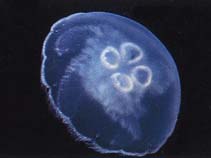Advertisement
Aurelia aurita (Linnaeus, 1758)
Moon jelly| Native range | All suitable habitat | Point map | Year 2050 |

|
| This map was computer-generated and has not yet been reviewed. |
| Aurelia aurita AquaMaps Data sources: GBIF OBIS |
France country information
Common names:
[No common name]
Occurrence: native
Salinity: marine
Abundance: | Ref:
Importance: | Ref:
Aquaculture: never/rarely | Ref:
Regulations: no regulations | Ref:
Uses: no uses
Comments:
National Checklist:
Country Information: https://www.cia.gov/library/publications/resources/the-world-factbook/geos/fr.html
National Fisheries Authority:
Occurrences: Occurrences Point map
Main Ref: Carpine, C., 1987
National Database:
Occurrence: native
Salinity: marine
Abundance: | Ref:
Importance: | Ref:
Aquaculture: never/rarely | Ref:
Regulations: no regulations | Ref:
Uses: no uses
Comments:
National Checklist:
Country Information: https://www.cia.gov/library/publications/resources/the-world-factbook/geos/fr.html
National Fisheries Authority:
Occurrences: Occurrences Point map
Main Ref: Carpine, C., 1987
National Database:
Common names from other countries
Classification / Names Κοινά ονόματα | Συνώνυμα | Catalog of Fishes (gen., sp.) | ITIS | CoL | WoRMS
Environment: milieu / climate zone / depth range / distribution range Οικολογία
Πελαγικό(ά); Υφάλμυρο; εύρος βάθους 0 - 1250 m (Αναφ. 116114). Subtropical; 78°N - 55°S, 180°W - 180°E
Distribution Χώρες | Περιοχές FAO | Οικοσυστήματα | Παρουσίες | Εισαγωγές
Circumglobal. This species is widespread in all the seas of the sphere, from the equator to the poles. Subtropical to polar.
Length at first maturity / Μέγεθος / Weight / Age
Maturity: Lm ?, range 2 - 31 cm Max length : 50.0 cm WD αρσενικό/απροσδιόριστο; (Αναφ. 2376)
Short description Μορφολογία
Maximum diameter: 50 cm (Ref. 358); Height, from 10 to 12.5 cm; diameter, being able to reach 40 to 50 cm (Ref. 363). Plane sunshade; comprising very many tentacles courts with the periphery. One counts 4 oral arms; and 4 sexual organs; of annular form or in the horseshoe shape very many radiate channels. Coloring: generally translucent, with slightly pink reflections, blue or purple; the sexual organs are more clearly colored red or pink (Ref. 358).
This species is being eaten by predators because of its high fatty acid content (Ref. 122155). Neritic, potentially pathogenic (Ref. 116114). Free living near the water's surface in pelagic zones (Ref. 2997), close to coasts (Ref. 358), and offshore (Ref. 813); also found in brackish waters (Ref. 2993), coastal embayments, fjords and estuaries (Ref. 3289). Their cnidocytes cannot transpierce the human skin. Suspension feeder (Ref. 3269) on tintinnids, rotifers, cladocerans and larvae of copepods (harpacticoid), barnacles (nauplii; Ref. 3053) and on fish larvae (Ref. 7715). Several cases reported sea anemones to feed on this species; fungiid coral is also an occasional feeder. Provides vital fatty acids for fishes and crustacean predators. Nutritional value of this species from macronutrients and key fatty acids appears to be important over only meeting a predator's energy demands (Ref. 122155).
Life cycle and mating behavior Γεννητική Ωρίμανση | Αναπαραγωγή | Γεννοβολία | Eggs | Γονιμότητα | Larvae
High abundances of ephyrae during late autumn can be explained by the large number of poly disc scyphistomae preceding to the appearance of ephyrae (Ref. 3062). Polyps begin to develop in August-September, matures in October and dies in November (Ref. 3271). Budding doesn’t occur in winter months (Ref. 7721). Can live up to 2 years (Ref. 3049).
Main reference
Αναφορές | Συντονιστής | Συνεργάτες
Wrobel, D. and C.E. Mills. 1998. (Αναφ. 2376)
IUCN Red List Status
(Αναφ. 130435: Version 2024-2)
CITES status (Αναφ. 108899)
Not Evaluated
CMS (Αναφ. 116361)
Not Evaluated
Human uses
αλιεία: Εμπορικό(ά)
| FishSource |
Εργαλεία
Περισσότερες πληροφορίες
Διαδικτυακές πηγές
BHL | BOLD Systems | CISTI | DiscoverLife | FAO(Publication : search) | GenBank (genome, nucleotide) | GloBI | Gomexsi | Google Books | Google Scholar | Google | PubMed | Δέντρο Ζωής | Wikipedia (Go, αναζήτηση) | Zoological Record
Estimates based on models
Preferred temperature
(Ref. 115969): 4.7 - 25.3, mean 12.3 (based on 3533 cells).
Ελαστικότητα
(Αναφ. 69278)
Υψηλό, ελάχιστος χρόνος για διπλασιασμό πληθυσμού < 15 μήνες (K=0.45-3.83).
Price category
(Αναφ. 80766):
Unknown.




